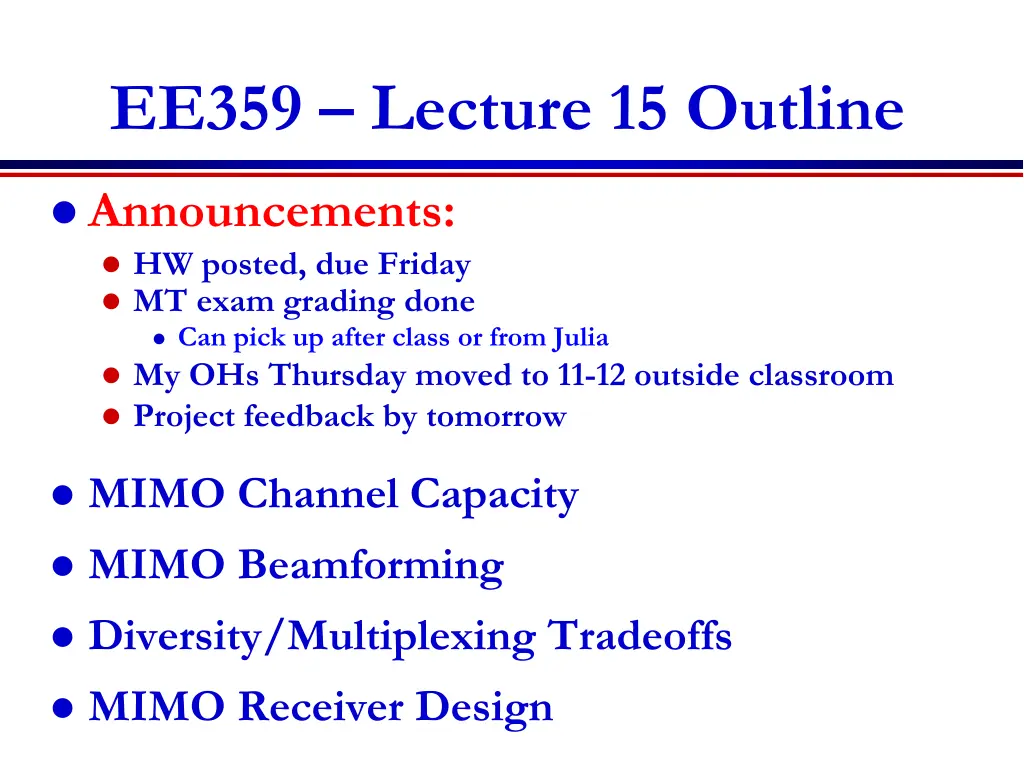
MIMO Channel Capacity and Beamforming Tradeoffs
Explore the concepts of MIMO channel capacity, beamforming, diversity, and multiplexing in wireless communication systems. Understand the tradeoffs between diversity and multiplexing, optimizing beamforming, and utilizing multiple antennas for improved performance. Dive into topics such as fading channel capacity, scalar coding with transmit precoding, and the impact of knowledge on system optimality.
Download Presentation

Please find below an Image/Link to download the presentation.
The content on the website is provided AS IS for your information and personal use only. It may not be sold, licensed, or shared on other websites without obtaining consent from the author. If you encounter any issues during the download, it is possible that the publisher has removed the file from their server.
You are allowed to download the files provided on this website for personal or commercial use, subject to the condition that they are used lawfully. All files are the property of their respective owners.
The content on the website is provided AS IS for your information and personal use only. It may not be sold, licensed, or shared on other websites without obtaining consent from the author.
E N D
Presentation Transcript
EE359 Lecture 15 Outline Announcements: HW posted, due Friday MT exam grading done Can pick up after class or from Julia My OHs Thursday moved to 11-12 outside classroom Project feedback by tomorrow MIMO Channel Capacity MIMO Beamforming Diversity/Multiplexing Tradeoffs MIMO Receiver Design
Midterm Grade Distribution Mean: 76, STD: 11 Rough curve 85-95: A+ 75-84: A 65-74: A- 60-64: B+ 2016: Mean: 73.08, STD:10.4.
Grade breakdown by problem Capacity of flat- fading channels Performance in shadowing and fading w/wout diversity Time-varying channel characterization
Review of Last Lecture MIMO systems have multiple TX and RX antennas System model defined via matrices and vectors Channel decomposition: TX precoding, RX shaping y=Hx+n ~ ~ ~ y= x+n H=U VH ~ ~ ~ yi= x+ni Capacity of MIMO Systems Depends on what is known at TX/RX and if channel is static or fading For static channel with perfect CSI at TX and RX, power water-filling over space is optimal: Without transmitter channel knowledge, capacity metric is based on an outage probability Pout is the probability that the channel capacity given the channel realization is below the transmission rate. Massive MIMO: in high SNR, singular values converge to a constant: C=min(Mt,Mr)Blog(1+ ): will revisit after fading analysis
MIMO Fading Channel Capacity If channel H known, waterfill over space (fixed power at each time instant) or space-time Without transmitter channel knowledge, capacity is based on an outage probability Pout is the probability that the channel capacity given the channel realization is below the transmission rate.
Beamforming Scalar codes with transmit precoding 1v 1x 2x 1u 2v 2 u y x v u x M M M t r t y=uHHvx+uHn Transforms system into a SISO system with diversity. Array and diversity gain Greatly simplifies encoding and decoding. Channel indicates the best direction to beamform Need sufficient knowledge for optimality of beamforming
Diversity vs. Multiplexing Use antennas for multiplexing or diversity Low Pe Error Prone Diversity/Multiplexing tradeoffs (Zheng/Tse) P log e = SNR ( ) SNR d lim log SNR R(SNR) = lim SNR r log SNR = * d (r) (M r)(M r) t r
How should antennas be used? Use antennas for multiplexing: ST Code High Rate High-Rate Quantizer Decoder Error Prone Use antennas for diversity ST Code High Diversity Low-Rate Quantizer Decoder Low Pe Depends on end-to-end metric: Solve by optimizing app. metric
MIMO Receiver Design Optimal Receiver: Maximum likelihood: finds input symbol most likely to have resulted in received vector Exponentially complex # of streams and constellation size Linear Receivers Zero-Forcing: forces off-diagonal elements to zero, enhances noise Minimum Mean Square Error: Balances zero forcing against noise enhancement Sphere Decoder: Only considers possibilities within a sphere of received symbol. If minimum distance symbol is within sphere, optimal, otherwise null is returned = 2 H x arg Q x min Rx y | | Q y Rx = 2| x arg min x | y Hx H :| | r
Main Points Capacity of fading MIMO systems With TX and RX channel knowledge, water-fill power over space or space-time to achieve capacity Without TX CSI, outage is the capacity metric For asymptotically large arrays, at high SNR, capacity is constant Beamforming transforms MIMO system into a SISO system with TX and RX diversity. Beamform along direction of maximum singular value MIMO introduces diversity/multiplexing tradeoff Optimal use of antennas depends on application MIMO RX design trades complexity for performance ML detector optimal - exponentially complex Linear receivers balance noise enhancement against stream interference Sphere decoding provides near ML performance with linear complexity
